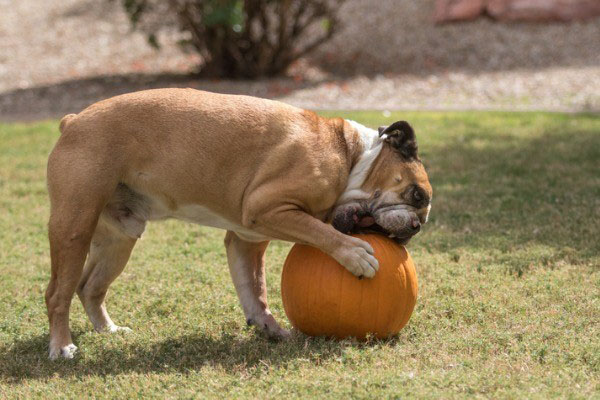The Importance of Seasonal Feeding
Nature is circular with constant energetic flux forming rhythms and patterns. If you can tap into these energies and use the repetitiveness of the seasons for feeding you’ll see the same patterns and rhythms in your dog.
Using nature as a guide is the basis for seasonal feeding. Seasonal feeding helps you get in a self-curing state of mind. The seasons influence different parts of your dog’s body. If you continually support these systems and organs as the year goes by, the body can balance itself.
Seasonal feeding gets you out of the rut of providing the same foods over and over again. All proteins, vegetables, grains and herbs have hot, cold, moist and dry energetic properties. When you work to combine and address the patterns in your dog, the food and the conditions of the season you can balance out broad physiological patterns in the body.
Seasonal feeding isn’t hard it just takes planning and practice. Take an assessment of how and what you’re already doing and adjust from there.
Autumn Energies
The earth’s energies start to close down during this time. This season’s energy focuses on the lungs and the large intestine.
As part of the respiratory system, the lung’s, their multiple lobes and airways take in air, oxygenate blood and send it to the heart.
The lungs need support and care because they are difficult to treat in dogs, especially for those types with short snouts.
Conditions of the lungs don’t always give us the time to work with them as much as other systems of the body because breathing is such an important part of what the body does to stay alive. The Lungs are also sensitive to dry weather so if your climate is dry in the fall, your dog is at an extra risk for bronchial conditions.
The large intestine works with the small intestine as part of the digestive tract and elimination systems. It facilitates water and electrolyte absorption as well as a wealth of beneficial intestinal bacteria which aid in digestion and elimination.
During Autumn, be mindful of the emotional wellbeing of your dog as well as their elimination and breathing.
Imbalances in these regions may manifest as a nasal and eye discharge, dandruff, worms, and excessive shedding.
Health conditions in your dog associated with Autumn include: sneezing, itching, bloating in intestine, constipation or diarrhea, coughing and pneumonia.
Autumn Proteins
For optimum health in your dog include neutral to slightly warming proteins like beef, duck, or rabbit as a base and rotate in warmer proteins like goat, chicken, and turkey.
Older dogs may need warmer base proteins like wild game.
Autumn Herbs
Three herbs that focus on the lungs and elimination are Mullein, Calendula and Echinacea.
Mullein supports the lungs by opening passage ways and reducing tightness. It also aids water absorption in the large intestine. Usually, I like to use mullein as a tincture, adding 2-5 drops into my dog’s food a couple times per day. Mullen leaves can be used as a tea, steeped for 30 minutes before adding to your dogs meal.
Calendula is warming and drying to the lungs and relieves excess moisture in the entire respiratory system while soothing digestive mucosa and membranes. It’s a great warming herb to have around.
One thing to note about using Calendula is that it regulates bacterial growth without killing it. This is the key to having a super charged immune system going into winter.
Unless it’s a life or death situation, I would never recommend giving a dog antibiotics in Autumn or Winter. Destroying beneficial bacteria in these seasons can reak havoc on your dog’s entire system. Changing your dog’s tissue terrain is a better way to control bacteria overgrowth and calendula can help with that.
Give Calendula as a steeped tea, (30 min or more) fresh or dried in your dogs food. You can also give as a tincture, giving 2-3 drops 2x daily during the fall season.
I love Echinacea because it balances, cleanses, and clears heat out of the lungs. Both Echinacea Purpea and Echinacea Augustfolia work well.
You can use Echinacea as a tincture, using 1-3 drops on food for two weeks on and one week off during the season or a tea infusion steeping 30 minutes and putting on the food a few times per week.
Autumn Vegetables
Autumn vegetables are some of my dogs favorite. Early fall choices include green beans.
Green beans help tonify the liver and the lungs as well as nourish the nervous system and support elimination.
Next up is Pumpkin. Pumpkin is a familiar vegetable in the animal world and used for fiber in the diet. Pumpkin benefits both the lungs and the large intestine. It helps protect the mucus membranes in the large intestine while supporting beneficial bacteria.
Pumpkin cleans out the large intestine as well as removes parasites. Grind up the raw seeds and feed 1/4 tsp per 10 pounds of body weight for worm prevention. Do this for 7 days on and 7 days off at least one time during the season.
Parsnips resemble carrots. They boost the immune system as well as help clean and tone the digestive system.
High in manganese, antioxidants, and vitamins, Parsnips are anti-inflammatory and aid in respiratory health. I lightly steam parsnips when giving them to my dogs or feed them raw after they have been put in a food processor.
Combining seasonally targeted proteins, herbs and vegetables can really help give you a seasonal plan that works for your dog’s specific needs. In our next articles, we’ll cover Winter and Spring.

